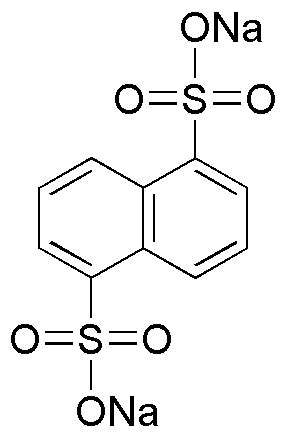1,5-Naphthalenedisulfonic acid disodium salt is widely utilized in research focused on:
- Dyes and Pigments: This compound serves as a key intermediate in the production of various dyes, particularly in the textile industry, providing vibrant colors and excellent lightfastness.
- Analytical Chemistry: It is used as a reagent in analytical methods, such as spectrophotometry, to detect and quantify metal ions, enhancing the accuracy of environmental testing.
- Pharmaceuticals: The compound plays a role in drug formulation, particularly in the development of sulfonamide antibiotics, improving solubility and bioavailability.
- Water Treatment: It is effective in water treatment processes, acting as a dispersant for sludge and enhancing the removal of contaminants, which is crucial for maintaining water quality.
- Research Applications: In biochemistry, it is used as a stabilizing agent for proteins and enzymes, facilitating various biochemical assays and enhancing the reliability of experimental results.
General Information
Properties
Safety and Regulations
Applications
1,5-Naphthalenedisulfonic acid disodium salt is widely utilized in research focused on:
- Dyes and Pigments: This compound serves as a key intermediate in the production of various dyes, particularly in the textile industry, providing vibrant colors and excellent lightfastness.
- Analytical Chemistry: It is used as a reagent in analytical methods, such as spectrophotometry, to detect and quantify metal ions, enhancing the accuracy of environmental testing.
- Pharmaceuticals: The compound plays a role in drug formulation, particularly in the development of sulfonamide antibiotics, improving solubility and bioavailability.
- Water Treatment: It is effective in water treatment processes, acting as a dispersant for sludge and enhancing the removal of contaminants, which is crucial for maintaining water quality.
- Research Applications: In biochemistry, it is used as a stabilizing agent for proteins and enzymes, facilitating various biochemical assays and enhancing the reliability of experimental results.
Documents
Safety Data Sheets (SDS)
The SDS provides comprehensive safety information on handling, storage, and disposal of the product.
Product Specification (PS)
The PS provides a comprehensive breakdown of the product’s properties, including chemical composition, physical state, purity, and storage requirements. It also details acceptable quality ranges and the product's intended applications.
Certificates of Analysis (COA)
Search for Certificates of Analysis (COA) by entering the products Lot Number. Lot and Batch Numbers can be found on a product’s label following the words ‘Lot’ or ‘Batch’.
*Catalog Number
*Lot Number
Certificates Of Origin (COO)
This COO confirms the country where the product was manufactured, and also details the materials and components used in it and whether it is derived from natural, synthetic, or other specific sources. This certificate may be required for customs, trade, and regulatory compliance.
*Catalog Number
*Lot Number
Safety Data Sheets (SDS)
The SDS provides comprehensive safety information on handling, storage, and disposal of the product.
DownloadProduct Specification (PS)
The PS provides a comprehensive breakdown of the product’s properties, including chemical composition, physical state, purity, and storage requirements. It also details acceptable quality ranges and the product's intended applications.
DownloadCertificates of Analysis (COA)
Search for Certificates of Analysis (COA) by entering the products Lot Number. Lot and Batch Numbers can be found on a product’s label following the words ‘Lot’ or ‘Batch’.
*Catalog Number
*Lot Number
Certificates Of Origin (COO)
This COO confirms the country where the product was manufactured, and also details the materials and components used in it and whether it is derived from natural, synthetic, or other specific sources. This certificate may be required for customs, trade, and regulatory compliance.


